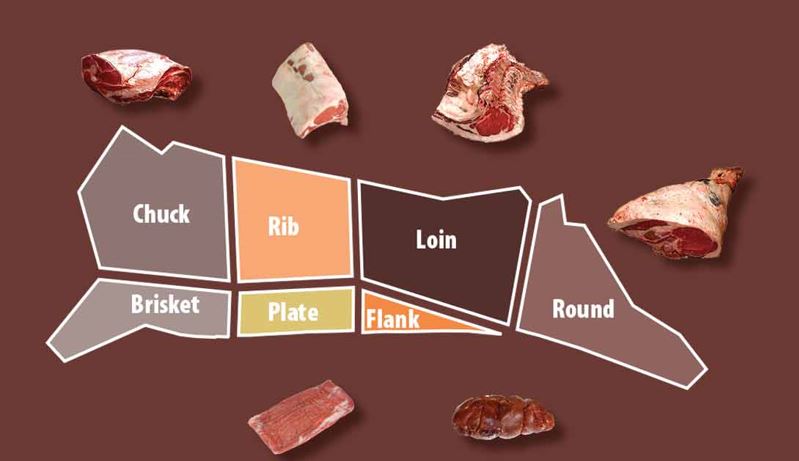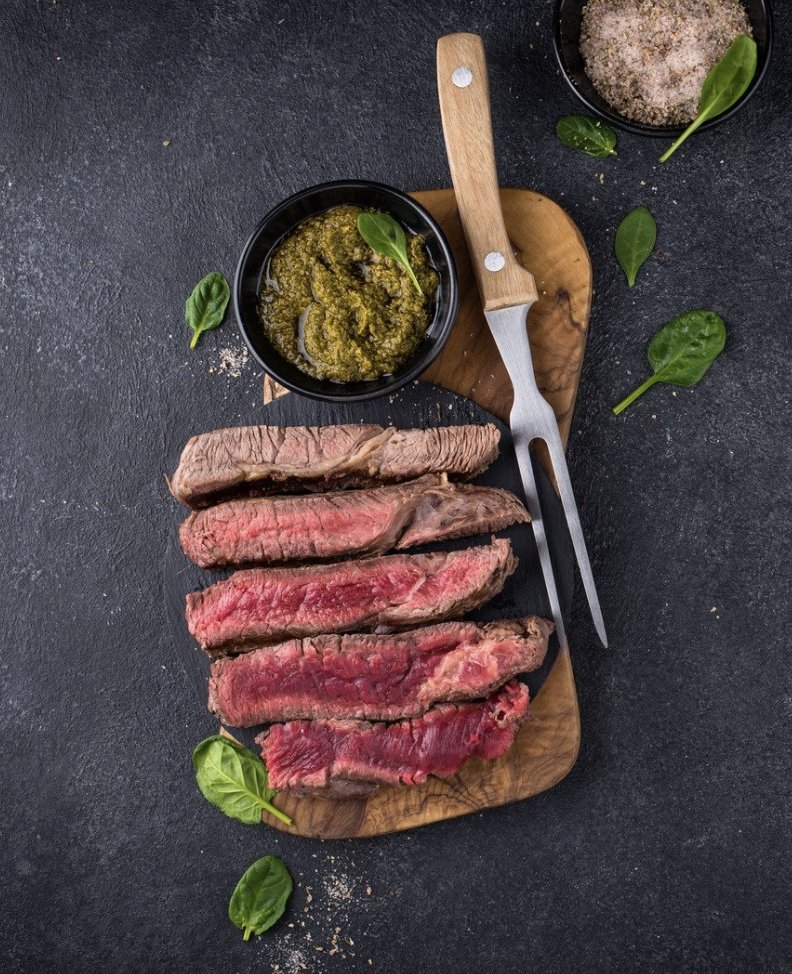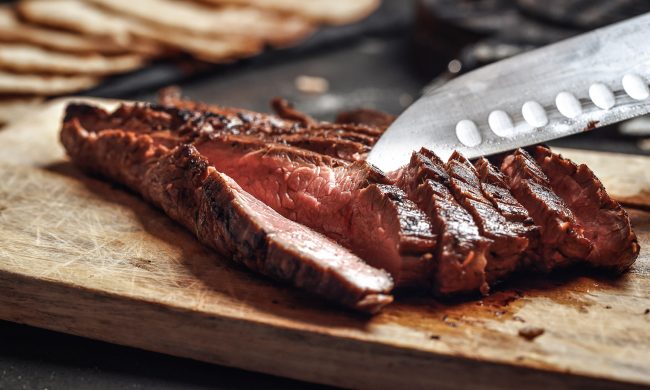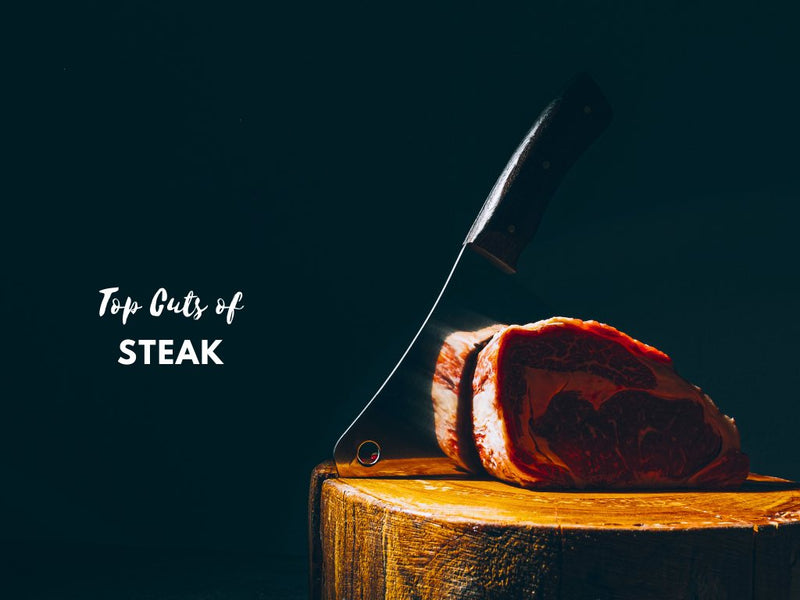The World of Steak Cuts
Getting to Know Your Cuts: Ribeye, Filet Mignon, T-Bone, and Others
If you love steak you probably know that each cut has its own flavor and texture. Knowing about these cuts can really level up your meal experience.
- Ribeye: Ribeye is loved for its marbling. It packs a ton of flavor and stays tender thanks to the fat which makes it juicy. It’s awesome on the grill since it gives you a crispy crust while staying moist inside.
- Filet Mignon: This cut is famous for being the softest. Filet mignon is lean and melts in your mouth. Its subtle taste is perfect for anyone who doesn’t want a steak that’s too strong. A light red wine pairs great with it.
- T-Bone: Think of this cut as two steaks in one. It’s got tenderloin (filet mignon) on one side and strip steak on the other. It’s great for gatherings and gives you both tenderness and great flavor.
Once you know these cuts you can easily pick out the one that’ll hit the spot.
What Makes Steak Tender?
Tenderness depends on a few key things:
- Muscle Usage: Cuts from muscles that don’t work as much like the tenderloin are usually more tender.
- Marbling: The fat throughout the steak can improve tenderness and flavor like in ribeyes.
- Aging: Dry aging can really amp up tenderness by helping break down the muscle fibers.
Knowing these aspects means making good choices to enjoy steak at its finest.

Finding the Most Tender Cuts
Wagyu: The Ultimate Tender Steak
When it comes to tender steak Wagyu is often seen as the top choice. Coming from Japan, this cattle breed is loved for its amazing marbling that gives it a rich buttery taste. For many food lovers Wagyu is a dream come true as it melts away in your mouth.
- Wagyu Characteristics:
- Incredible marbling that boosts tenderness
- Juicy in every bite
- Mild flavor that lets the meat shine
To savor Wagyu make sure to keep it simple—grill or pan-sear to medium-rare and let its natural flavor come through.
USDA Prime vs. Choice Cuts
Knowing the difference between USDA Prime and Choice cuts can help you pick the right steak.
- USDA Prime:
- Top quality with lots of marbling
- Great for special meals since it’s more expensive
- Perfect for grilling to keep it juicy
- USDA Choice:
- Good quality but slightly less than Prime
- More budget-friendly for everyday meals
- Works well for marinating or slow cooking
Both grades are great for steak dinner. The right choice depends on your occasion and budget which means a happy steak experience every time.

Cooking Techniques for Tender Steaks
Sous Vide Method: Perfect Steaks Every Time
If you’re looking to take your steak cooking to the next level the sous vide method is where it’s at. This trick involves sealing your steak in a bag and cooking it slowly in a water bath at a steady temperature.
- Benefits of Sous Vide:
- Keeps it juicy every time.
- Cooks evenly so there’s no overcooked edge.
To get the best results set your sous vide cooker to your target temperature usually between 129°F for medium-rare and 145°F for medium. After cooking give it a quick sear in a hot pan for that awesome crust that contrasts nicely with the tender inside.
Reverse Searing: Keeping the Juiciness
Reverse searing is another popular trick for juicy steaks. This method turns the usual cooking method upside down.
- How Reverse Searing Works:
- Start slow in the oven at a low temp (around 250°F) til it’s close to your perfect doneness.
- Sear in a hot cast-iron skillet for that perfect crust.
This method cooks it evenly and cuts down the chances of ruining those tender edges. The outcome? A steak that’s tender and full of flavor with a beautifully browned outside. Whether you go for sous vide or reverse searing both methods amp up tenderness and flavor to make each bite a treat.

Pairing Tips for Steak Fans
Wine Pairings: Making Steak Even Better
To really enhance your steak feast picking the right wine is key. A full-bodied red often does the trick as it pairs beautifully with the rich flavors of beef. Here are some great choices:
- Cabernet Sauvignon: This classic wine brings strong tannins and dark fruit flavors that balance out juicy ribeye or T-bone steaks perfectly.
- Malbec: Known for its rich fruit and spicy notes, Malbec is fantastic with grilled steaks, especially when they are seasoned boldly.
- Syrah/Shiraz: This grape gives a peppery punch that goes really well with a nice New York strip or filet.
Why not throw a steak night and try some wine? Grab a few bottles of these wines, and see which one pairs best with your steak!
Sides and Sauces: Boosting the Flavor
While wine can boost the taste great sides and sauces can complete your steak meal. Here are some popular options:
- Roasted Veggies: Fresh veggies like asparagus or Brussels sprouts add crunch and freshness—a perfect balance to a rich meal.
- Creamy Mashed Potatoes: These buttery potatoes go well with any steak.
- Classic Steak Sauces: A hint of chimichurri or a touch of peppercorn sauce can really amplify your steak’s flavor for an exciting contrast.
Trying out different pairings can lead to yummy surprises turning an average steak dinner into a fancy feast. So when you’re firing up the grill don’t forget that great sides are just as important as the steak!
Steak Selection and Storage
Choosing Tender Steaks at the Butcher
Picking the right steak at the butcher matters a lot. Here are some tips to help you score a tender cut every time:
- Look for Marbling: The white spots of fat in the meat are called marbling. Good marbling enhances flavor and makes cuts like ribeye and sirloin tender.
- Check the Color: Fresh steak should be a bright red. If it looks dull or brown it might not be fresh.
- Feel the Texture: Press gently on the steak; it should feel firm and bounce back a bit. Stay away from cuts that feel mushy which could mean spoilage.
- Ask Questions: Don’t be afraid to chat with your butcher. They can give you great tips on the best cuts based on how you’ll cook them.
Picking out the right cut isn’t just about what you know—it’s also about finding a butcher you can trust.
Best Practices for Storing Steaks
After you’ve picked out your steak, storage is key to keeping it fresh. Here are some essential tips:
- Refrigerate Right Away: Get your steak into the coldest part of the fridge as soon as you can. Use a meat drawer if you have one.
- Use Airtight Packaging: If you won’t cook it in a day or two wrap it tight in plastic, then foil, or vacuum-seal it to keep prevent freezer burn.
- Freeze for Later: For long-term storage make sure it’s wrapped well and label it with the date.
- Thaw the Right Way: When you’re ready to use it thaw steak in the fridge overnight. Don’t leave it out on the counter to thaw or you risk germs.
By following these storing and selecting tips you’ll make sure every steak you cook is fresh and full of flavor. Whether it’s for a special occasion or just a weekday dinner these practices can really up your steak game.

Discovering Global Steak Delicacies
Japanese Kobe Beef: A Special Treat
When talking steak few experiences can match the luxury of Kobe beef. Coming from the Tajima breed of Wagyu cattle, Kobe beef is known for its amazing marbling, tenderness, and rich taste. Raising these cattle involves special diets and care such as giving them massages to help their muscles grow.
- Special Features:
- Awesome Marbling: The white fat streaks throughout create a rich buttery texture.
- Flavor: The unique rearing methods lead to a sweet, savory taste that’s hard to beat.
Eating Kobe beef is more than having a meal it’s about savoring an experience. Pair it with a light red wine to elevate your food adventures!
Argentinian Asado: A Grilling Tradition
On the flip side of luxury you have Argentinian Asado that really captures the essence of grilling culture. This traditional way of cooking beef is done over an open flame which gives it a smoky flavor.
- Main Features:
- Cuts Used: Common cuts include flank steak (vacío), short ribs, and skirt steak all known for robust flavors.
- Keeping it Simple: The focus is on the meat itself usually seasoned lightly with salt to let the flavor shine.
Asado isn’t just about the food it’s a gathering. Friends and family come together to share stories while those delicious steaks are grilling. If you find yourself in Argentina joining in on an Asado is a must—it’s a tasty celebration of culture and togetherness!
Healthy Eating with Steak
Balancing Protein and Steak
Steak can be a great protein source giving you essential amino acids that help with muscle repair. But like anything moderation is important. The American Heart Association suggests adults get around 46 to 56 grams of protein each day depending on how active they are.
- Why Steak?:
- Packed with important nutrients like iron, zinc, and B vitamins that are vital for energy and the immune system.
- High-quality steaks especially grass-fed ones can be lean yet satisfying, letting you enjoy without excess fat.
Try mixing steaks with other protein sources like beans or nuts during the week for a balanced diet.
Enjoying Steaks While Staying Healthy
You can enjoy steak without giving up on your health. Here are tips to make steak a part of a balanced diet:
- Watch Portions: Aim for a steak serving of around 3-4 ounces about the size of your palm. This helps control calorie intake while enjoying the taste of good beef.
- Pick Leaner Cuts: Go for lean cuts like filet mignon or sirloin to keep saturated fat in check.
- Add Colors: Pair your steak with a variety of colorful veggies. Side salads, grilled asparagus, or roasted Brussels sprouts brighten up your meal and add fiber.
With these tips you can relish the good flavors of steak while keeping a healthy balance! A well-rounded diet helps you enjoy your food while taking care of your body.

Leave a Reply